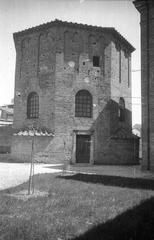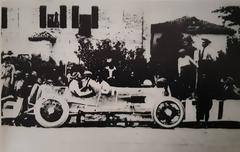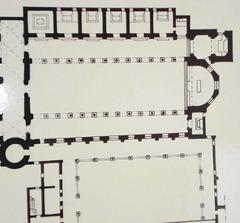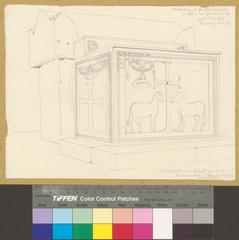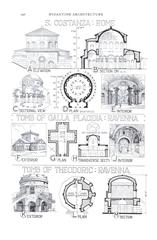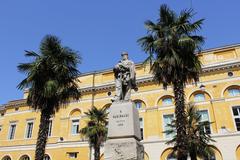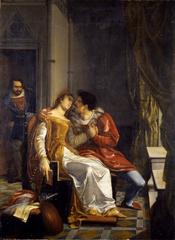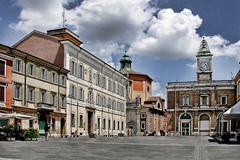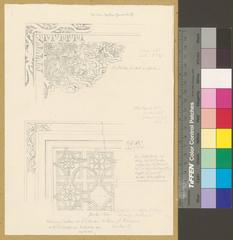Palazzo Comunale Ravenna: Your Detailed Guide to Visiting Hours, Tickets, and Historical Insights
Date: 14/06/2025
Introduction
Situated at the heart of Ravenna’s historic center, the Palazzo Comunale—also called Palazzo Merlato—is a distinguished symbol of the city’s civic authority and architectural heritage. Since the late 13th century, this landmark has witnessed Ravenna’s journey from an imperial capital to a flourishing medieval and Renaissance city. It fuses medieval fortifications with Renaissance elegance, highlighted by its Ghibelline battlements, Venetian Gothic portico, and interiors adorned with frescoes and period furnishings. Although primarily serving as the headquarters for Ravenna’s municipal government, the Palazzo occasionally opens to the public during special events and guided tours, offering a rare window into centuries of political, cultural, and urban evolution (Catalogo Beni Culturali; Turismo Ravenna; My Global Viewpoint; Mapcarta).
Table of Contents
- Introduction
- Historical Overview
- Architectural Evolution
- The Palazzo and Piazza del Popolo
- Artistic and Cultural Heritage
- Modern Role and Preservation
- Visiting Hours & Tickets
- Accessibility and Travel Tips
- Nearby Attractions
- Visitor FAQs
- Summary and Final Tips
- References
Historical Overview
Medieval Foundations
The Palazzo Comunale originated in the late 13th century, signifying Ravenna’s transition from imperial governance to a medieval commune. Its location—adjacent to Piazza del Popolo—placed it at the center of civic life, hosting government meetings, public announcements, and celebrations (Catalogo Beni Culturali; Mapcarta).
Renaissance to Modern Transformations
The 15th and 16th centuries saw the Palazzo redesigned with Renaissance elements: symmetrical facades, arched windows, and ornamental cornices. The palazzo was further expanded in the 18th and 19th centuries, notably with its third floor (1761) and the addition of distinctive Ghibelline battlements in 1857 (Turismo Ravenna).
Architectural Evolution
Layout and Structures
The Palazzo comprises two main wings:
- Palazzetto Veneziano (north): Notable for its Venetian Gothic portico, supported by granite columns topped with 6th-century marble capitals displaying King Theoderic’s monogram.
- Palazzo del Comune (west): The principal building, expanded over centuries and crowned with battlements that evoke medieval fortifications (Turismo Ravenna).
A covered passage (voltone) with 19th-century frescoes connects these wings over Via Cairoli.
Exterior Features
- Portico & Columns: The portico’s ancient columns and capitals reflect Ravenna’s Ostrogothic and Venetian past.
- Battlements: The swallowtail battlements not only add to the palazzo’s fortified appearance but also symbolize its authority.
- Piazza Integration: The building harmonizes with Piazza del Popolo, framed by other Venetian-era structures and two columns topped with statues of San Vitale and Sant’Apollinare (travelemiliaromagna.it).
The Palazzo and Piazza del Popolo
Piazza del Popolo, redesigned in the late 15th century, became Ravenna’s social and civic epicenter, with the Palazzo Comunale as its architectural anchor. The palace’s balconies and loggias allowed officials to address citizens directly, and both the square and the building have been central to Ravenna’s political and social life for centuries (My Global Viewpoint).
Artistic and Cultural Heritage
The Palazzo’s interiors—open to the public only during special events—are decorated with frescoes, sculptures, and archival documents. Highlights include:
- Council Chamber (Sala del Consiglio Comunale): Features a vaulted ceiling painted by Gaetano Savini (1882) and busts of Italian leaders.
- Covered Passage: Adorned with 19th-century frescoes celebrating Ravenna’s heritage.
- Symbolic Elements: Ancient capitals with Theoderic’s monogram and allegorical figures underscore the palazzo’s link to the city’s layered history (Turismo Ravenna).
Modern Role and Preservation
Today, the Palazzo Comunale houses the mayor’s office, city council, and administrative departments. Restoration projects in the 19th and 20th centuries have preserved its historical character, while adapting the space for contemporary civic functions. The building is also used for cultural events, exhibitions, and civil ceremonies (Mapcarta).
Visiting Hours & Tickets
Public Access:
- Exterior: Piazza del Popolo and the palazzo’s facade are accessible 24/7.
- Interior: Entry is generally limited to official business, special events, or guided tours.
Usual Opening Hours for Special Events or Tours:
- Monday–Friday: 7:30 AM – 7:30 PM
- Saturday: 7:30 AM – 1:30 PM
- Sunday: Closed
Admission:
- Exterior: Free
- Interior: Free during special events; guided tours (when available) may require advance booking.
Guided Tours: Offered occasionally by the municipality or cultural associations, often during festivals or heritage days. Check the Turismo Ravenna website or local tourist office for schedules.
Photography: Allowed for the exterior; check for restrictions during interior access.
Accessibility and Travel Tips
- Mobility: The square and portico are wheelchair-accessible. Elevators and ramps are available inside when open to the public (Turismo Ravenna).
- Location: Piazza del Popolo is a 10–15 minute walk from the railway station. The area is pedestrian-friendly and well-served by local buses.
- By Car: The historic center is a ZTL (limited traffic zone); parking is available in peripheral lots (Savoring Italy).
- Best Time to Visit: Spring and early autumn, or evenings for a lively atmosphere.
Nearby Attractions
- Basilica di San Vitale & Mausoleum of Galla Placidia: UNESCO World Heritage sites within a short walk.
- Dante’s Tomb: A must-see for literature fans.
- Local Markets & Cafés: The square is surrounded by shops, restaurants, and vibrant market life (Savoring Italy).
Visitor FAQs
Can I visit the Palazzo Comunale every day?
The exterior and square are always accessible. Interior access is generally limited to special events, tours, or by prior arrangement.
Is there an entrance fee?
No fee for exterior access. Admission may apply for special guided tours.
Is the building accessible for people with disabilities?
Yes, the exterior and interior (when open) are accessible.
How do I get there from the train station?
A 10–15 minute walk or short bus ride.
Are guided tours available?
Occasional tours during festivals or heritage days; check with the tourist office.
Summary and Final Tips
Visiting Ravenna’s Palazzo Comunale is a journey through centuries of history, architecture, and civic pride. While interior access is limited, special events and guided tours unveil its art-filled chambers and rich heritage. Its prime location on Piazza del Popolo makes it a natural starting point for exploring Ravenna’s UNESCO monuments, Dante’s Tomb, and vibrant city life. For the best experience:
- Plan your visit around special events or festivals.
- Check official tourism platforms for up-to-date access information.
- Combine your visit with nearby historical and cultural attractions.
- Take advantage of accessible facilities and public transport.
Stay informed about events and guides by downloading the Audiala app and following Ravenna’s official tourism channels.
References
- Catalogo Beni Culturali
- Turismo Ravenna
- My Global Viewpoint
- Mapcarta
- Savoring Italy
- Turismo Ravenna – Theatres and Historical Buildings
- Turismo Ravenna – Palazzo Merlato (Palazzo Comunale)
- Travelemiliaromagna.it
